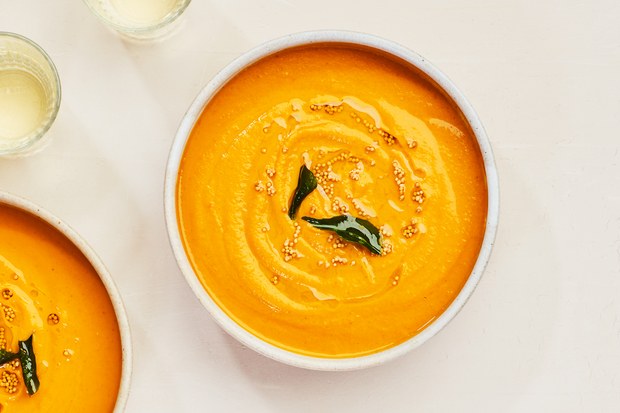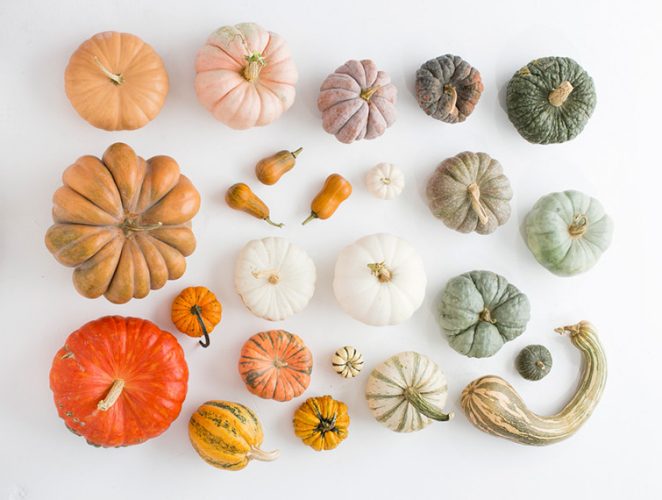First, they show up as pumpkin spice everything, then they begin to fill displays in grocery stores and farm stands. Nothing marks the change of seasons from summer to fall quite like pumpkins. Like many, this vegetable only showed up on my family’s table at Thanksgiving. Even after moving up to Michigan (where they are grown), I rarely saw them used for anything other than Halloween decorations or gooey, sweet, pumpkin pie. My pumpkin world vastly expanded years later, when I cooked with a Tibetan chef at a macrobiotic restaurant in Oakland. After that, my love affair with this healing food began. Pumpkins and winter squash of every shape, size, and color came through my kitchen from late September through February and were featured in more dishes than I could imagine.
Both Ayurveda and Traditional Chinese Medicine encourage eating with the seasons and consuming locally-grown foods to harmonize with our environment and strengthen health. If we eat the same foods all year long, we are not getting a balance of the six tastes and the elements associated with them. We often overload on sweet and salty tastes, omitting the sour, bitter, astringent, and pungent. This excess leads to stagnation of not only the body, but the mind as well. It’s the way humans evolved to eat but have forgotten over the years. Eating locally helps us attune with what is growing in each season and what naturally helps us accommodate to changing environmental factors, such as temperature, humidity, and length of day.
Autumn, known as vata season in Ayurveda, is ruled by the elements of space and air, with variations and instability dominating the season. To bring balance to this time, eating foods that are cooked, nourishing, hydrating, and slightly sweet is advised. Foods such as whole grains, soups, and hearty vegetables are optimal. Pumpkins and winter squash are wonderful for balancing vata and help clear excessive heat and dampness from the summer months (and abundant fruits). Additionally, they strengthen the lungs, digestive system (especially the colon), and help to balance blood sugar.
While all pumpkins and winter squash have these qualities, they vary in texture and best cooking methods. Butternut, acorn, spaghetti squash, and delicata are all lighter in nature and less sweet than traditional pumpkin. It’s best to steam them (either in a steamer basket or in a glass pan) with a bit of water and wrapped in foil to keep the moisture in. They can be spiced in many ways and served in slices, puréed into soups, or served instead of grains in a meal. On the other hand, kabocha, blue hubbard, and classic orange pumpkins are more hearty and sweet. They are also wonderful steamed, but because they are more starchy, they can be roasted in the oven to caramelize the natural sugars and bring out the nuanced flavors.
Experiment with different pumpkins and winter squash this season by heading to your local farmers’ market. Pick up a few different kinds and try them in various recipes. Try one of my favorites below:

Curried Pumpkin Soup
Ingredients
2 medium sweet onions, finely chopped (about 2 cups)
2 tbsps ghee
2 large garlic cloves, minced
1 ½ tbsps minced peeled fresh ginger
2 tsps ground cumin
1 tsp ground coriander
⅛ tsp ground cardamom
1 ½ tsps salt
1 tbsp ground black pepper
½ large kabocha, hubbard, or pumpkin, cut into cubes
4 cups water
1 ½ cups chicken or vegetable broth (about 12 fl oz)
14 oz can unsweetened coconut milk (not low-fat)
2 tsps brown mustard seeds
8 fresh curry leaves
¼ cup finely chopped cilantro leaves
1 tbsp coconut oil
Directions
- Cook onions in ghee in a wide, 6-quart heavy pot over moderately low heat, stirring occasionally, until softened, 3 to 5 minutes.
- Add ginger and cook about a minute, stirring occasionally minute.
- Add cumin, coriander, and cardamom and cook for another minute, stirring completely.
- Stir in pumpkin, water, and broth. Simmer uncovered, stirring occasionally for 30 minutes.
- Add salt, pepper, and coconut milk.
- Purée the soup in batches in a blender or with an immersion blender until smooth (use caution when blending hot liquids). Transfer to a large bowl and return soup to pot. Keep soup warm over low heat.
- Heat the coconut oil in a small, heavy skillet over moderately high heat until hot but not smoking.
- Then, cook mustard seeds until they begin to pop, about 15 seconds.
- Add curry leaves and cook 5 seconds, then pour mixture into pumpkin soup.
- Stir until combined well, and season soup with salt. Soup can be thinned with additional water.














